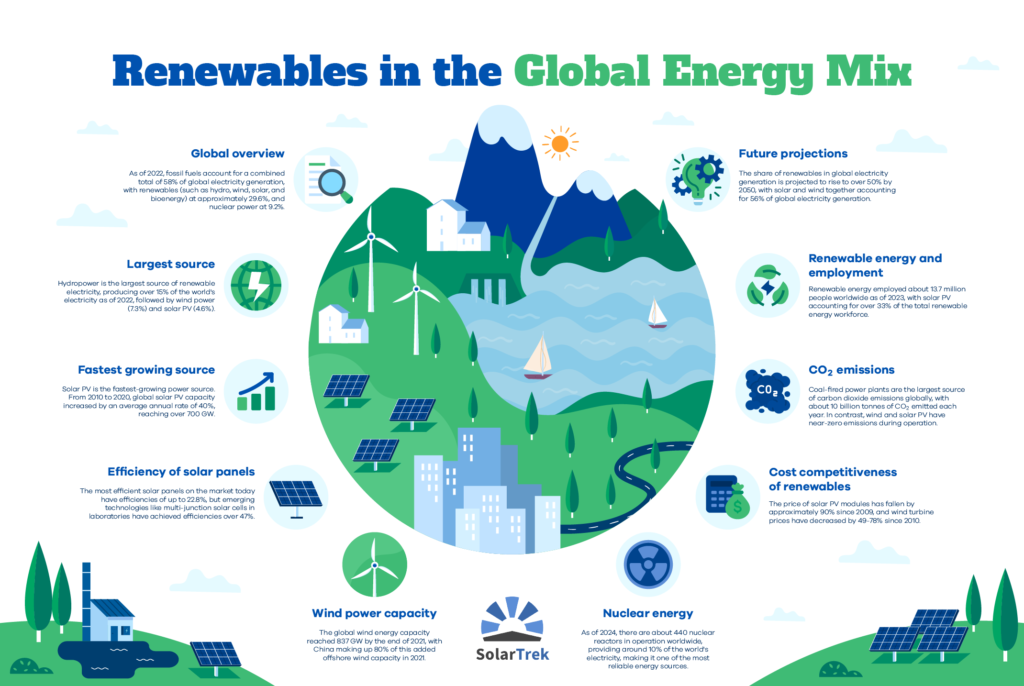Advancements in solar panel technology have rapidly progressed in recent years, and solar power is now a vital player in the pursuit of renewable energy solutions worldwide.
No longer are solar panels just an option for powering homes – their application now spans from small-scale residential setups to massive solar farms. These installations are particularly important in rural areas, especially in developing countries where many communities are off the grid. Similarly, urban towns and cities are benefiting from medium-scale projects, such as solar-powered public spaces and commercial rooftops.
The scalability of solar technology makes it adaptable across various environments and climates. From vast, sun-drenched deserts to small, cloudy regions, solar panels are increasingly tailored to meet specific geographic and climatic needs. This flexibility is one of the factors that gives solar power such an edge in global energy strategies, as governments and households alike try to reduce their reliance on fossil fuels and decrease greenhouse gas emissions.
As the uptake of solar technology increases, so do the enhancements in efficiency and cost-effectiveness continue, which only serves to make solar power more and more appealing as an option for a cleaner future.
Let’s take a look at some of the latest advancements in solar panel tech.
Advancements in Solar Cell Materials and Design
The solar industry is witnessing rapid advancements in material science, bringing forward new solutions like perovskites that transcend the traditional silicon boundaries. These innovative materials not only promise higher efficiencies but are also more cost-effective. Laboratory-scale perovskite solar cells have seen their efficiency rise from 3.8% in 2009 to an impressive 25.7% by 2021.
When combined with silicon in ‘tandem’ cells, which will be discussed more in the section below, these figures have reached up to 33.9%, pushing beyond the efficiency limits of conventional silicon cells. Additionally, multi-junction solar cells in laboratories have surpassed even these achievements, reaching efficiencies over 47%, according to the National Renewable Energy Laboratory (NREL).
Another exciting development in solar technology is the creation of colored and transparent solar panels. These panels are designed to blend seamlessly into building facades, windows, and other architectural features, offering a dual function of energy generation and aesthetic enhancement. Transparent solar panels, which use transparent photovoltaic materials, allow for natural light transmission while converting sunlight to electricity, making them ideal for urban environments where space and design are both important considerations.
Flexible solar cells are also breaking new ground, offering versatility in how and where solar technology can be deployed. These cells are based on materials that can be printed or coated onto flexible substrates, allowing them to be installed on surfaces that are not suitable for traditional panels. The potential applications range from integrating solar power into wearable technology to new forms of portable energy solutions.

Perovskite-Silicon Tandem Cells and Efficiency
Perovskite-silicon tandem cells are revolutionizing solar panel technology by significantly enhancing efficiency levels. Perovskite solar cells, which have been in development since 2009, use a perovskite-structured compound as the light-harvesting active layer. These materials are not only cost-effective but also relatively simple to manufacture, contributing to their rapid advancement in the solar industry.
The tandem design pairs the high-efficiency perovskite solar cells with traditional silicon cells to maximize solar energy conversion. This combination has enabled significant improvements over the maximum efficiencies possible with silicon-only solar cells.
For instance, breakthroughs in November 2023 have seen efficiencies soar to 33.9%, as achieved by researchers from the Chinese solar technology firm Longi. This figure is nearly 30% more efficient than the best-performing traditional silicon cells and pushes the technology closer to its theoretical efficiency limit of 43%.
The move from laboratory to commercial production has faced challenges, particularly with the durability and reliability of perovskite solar cells. However, a recent study led by the Karlsruhe Institute of Technology in Germany and the National Renewable Energy Laboratory (NREL) in the US suggests a promising solution. Published in the journal ‘Energy & Environmental Science,’ their research advocates for vacuum-based processes, which are already widely used in various high-tech industries, to manufacture these cells. This method holds significant advantages over the traditional solvent-based techniques used for lab-scale cells, potentially enabling commercial-scale production.
With the expected commercial viability within the next five years, companies like the UK-based Oxford PV and startups in China are advancing plans to establish production facilities. This progress indicates a significant step towards making high-efficiency solar power more accessible and affordable on a global scale, ensuring a sustainable future for solar energy technology.
Combining Solar with Other Technologies
The integration of solar photovoltaic (PV) systems with other technological solutions is enhancing the utility of renewable energy.
One key development in this area is the combination of solar panels with battery storage systems, also called “solar generators”. This combination allows for the storage of excess electricity generated during peak sunlight hours, which can then be used during periods of low sunlight or at night. Such setups significantly increase the practicality of solar systems for continuous energy supply, making solar power a more reliable standalone energy solution.
For more information about how solar generators can be integrated into day-to-day life, see our articles on How to Incorporate Solar Power into Off-Grid Setups, and Using Solar Generators for your Greenhouse Needs.
Hybrid projects that combine solar power with wind energy are also making progress. These projects harness the strengths of both solar and wind systems to provide a more consistent and balanced energy supply. By mitigating the variability of each technology – solar panels perform best on sunny days while wind turbines excel in windy conditions – hybrid systems can offer a more reliable output.
This complementary approach not only maximizes energy production but also contributes to a more stable and resilient energy grid. Several initiatives, including some led by major energy corporations like Iberdrola in Australia, are pioneering these integrated solutions, showcasing their potential to revolutionize how renewable energy is generated and consumed.
Solar Power Accessibility and Economic Factors
Government policies have played a significant role in accelerating the adoption of solar power. Feed-in tariffs, for instance, have been instrumental in boosting solar installations by offering homeowners and businesses financial incentives for installing solar panels and selling excess electricity back to the grid. Such policies not only make solar investments more attractive, but also speed up the return on investment, thus encouraging even greater participation in the uptake of solar power.
The economic landscape of solar technology has also been transformed by continuous advancements which have led to significant reductions in cost. Over the past decade, the cost of solar panels and related technologies has plummeted, driven by improvements in manufacturing processes and efficiencies in solar cell technology. This trend is illustrated by the sharp decline in the cost per watt of solar energy, making solar installations more affordable for a wider range of consumers and businesses globally.
These cost reductions are critical, as they enable competitive pricing compared to traditional energy sources, even without subsidies.

Advancements in Manufacturing and Scale
New manufacturing techniques are also emerging in the solar power tech space which significantly reduces costs and enhances production efficiency. One of the notable advancements is the implementation of automation and robotics in solar panel production lines. These technologies streamline the manufacturing process, reduce labor costs, and improve the consistency and quality of the solar panels produced.
Furthermore, advancements in materials science, such as the use of thinner yet more efficient photovoltaic materials, have also contributed to the reduction of material costs, as well as the improvement the environmental footprint of panel production.
Major players in the solar industry are at the forefront of these innovations. Companies like Longi Green Energy and First Solar are making substantial contributions to innovation with significant investments in research and development.
Longi, for instance, has been central in advancing monocrystalline technology, which is known for its high efficiency and long lifespan. Meanwhile, First Solar has made key contributions with their thin-film solar panels, which are not only cost-effective but also perform better in low-light conditions compared to traditional silicon panels.
Environmental Impact and Sustainability
The surge in solar energy adoption brings with it the responsibility to address environmental impacts associated with the life cycle of solar panels.
As the number of solar installations grows globally, so does the importance of having sustainable production methods and effective recycling processes. Solar panel recycling is an important step for minimizing waste and reclaiming valuable materials like silicon, silver, and glass. It is also necessary to develop sophisticated recycling technologies to further reduce the environmental footprint of solar energy.
And as solar technology advances, it’s more important than ever to balance these high-tech developments with environmental conservation efforts. The production of solar panels involves energy-intensive processes and the use of hazardous materials, which can pose challenges to environmental sustainability. Thankfully, the wider industry seems to recognize this, and is increasingly focused on improving the eco-friendliness of production techniques. This includes using less toxic materials and reducing energy consumption during manufacturing, which not only decreases the environmental impact, but also improves the overall sustainability of solar technologies.
The integration of life cycle assessments in the design and development phases of solar products is another strategy being adopted by energy companies to ensure environmental impacts are acknowledged and minimized. These assessments help manufacturers to identify and mitigate negative environmental impacts at every stage, from raw material extraction through to end-of-life disposal.
Global Solar Energy Adoption and Future Prospects
The adoption of solar energy on a global scale varies widely across different regions, due to geographic, economic, and policy factors. In areas that see a lot of sunlight, like the Middle East and parts of the US, solar energy has become a staple contributor to their energy mix.
But it isn’t all down to climate – European countries like Germany have also become key players globally, in part due to their successful implementation of policy frameworks and incentives to boost adoption of solar power.
The growth potential of solar energy continues to expand as technology evolves and costs decrease. Emerging markets, particularly countries in Africa and Asia, present significant opportunities for solar adoption. These regions, which are characterized by abundant sunlight and growing energy needs, are ideal candidates for significant solar power adoption. Innovations such as off-grid solar and microgrid solutions are particularly promising, offering reliable power sources to regions where traditional grid infrastructure is either underdeveloped or non-existent.
Solar technology is expected to continue to grow into various sectors and applications in the future. We are seeing the integration of solar technology into building materials, vehicles, and even roadways, making renewable energy more ubiquitous than ever.
Global focus on more sustainable practices is likely to drive further innovations in solar technology, including advancements in energy storage systems that can resolve intermittency issues and make solar power even more reliable. As governments and corporations worldwide continue to set ambitious goals on carbon neutrality, solar energy will certainly play an increasingly crucial role in achieving these objectives, promising to maintain a strong growth trajectory in the years to come.






